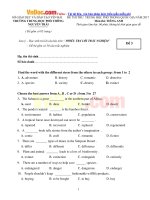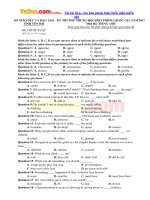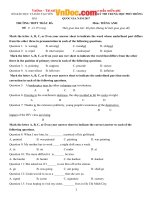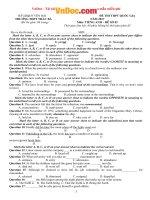Tải Đề thi thử THPT Quốc gia môn Tiếng Anh trường THPT Cảm Nhân, Yên Bái CÓ ĐÁP ÁN (3) - Ôn thi THPTQG môn Tiếng Anh có đáp án
Bạn đang xem bản rút gọn của tài liệu. Xem và tải ngay bản đầy đủ của tài liệu tại đây (104.99 KB, 4 trang )
<span class='text_page_counter'>(1)</span><div class='page_container' data-page=1>
<b>SỞ GD&ĐT YÊN BÁI</b>
<b>TRƯỜNG THPT CẢM NHÂN</b>
ĐỀ CHÍNH THỨC
Đề thi gồm có 04 trang
<b>KỲ THI THPT QUỐC GIA NĂM 2017</b>
<b>Môn: TIẾNG ANH</b>
<i>Thời gian làm bài: 60 phút, không kể thời gian phát đề</i>
<b>QUESTIONS 1 – 3: Choose one word whose underlined part is pronounced differently from the </b>
<b>rest in each group. Identify your answer by circling the corresponding letter A, B, C or D. Mark </b>
<b>your choice on the answer sheet.</b>
1. A. cheerful B. charity C. machine D. chance
2. A. field B. belief C. brief D. friend
3. A. between B. cheese C. cheep D. cheer
<b>QUESTIONS 4-5: Choose one option A, B, C or D corresponding to the word whose main stress is </b>
<b>on the syllable in the position which is different from that of the others. Identify your choice by </b>
<b>circling letter A, B, C or D on the answer sheet.</b>
4. A. between B. cherish C. chicken D. kitchen
5. A. exciting B. charity C. convenient D. surprising
<b>QUESTIONS 6-30: These are incomplete sentences. Choose A, B, C or D as your best choice to </b>
<b>complete each sentence and then identify your answer by circling letter A, B, C or D on the answer </b>
<b>sheet.</b>
6. Never in my life ………. Such a beautiful sunset.
A. I have seen B. I do see C. have I seen D. do I see
7. I will phone you ………. I get there.
A. as well as B. as much as C. as soon as D. as early as
8. If we heat water to 100 degrees Celsius, it
A. would boil B. will be boiling C. is boiling D. boils
9. After finishing the presentation, I suggested ………. To the cinema.
A. us to go B. that we to go C. going D. we going
10. If you do not learn seriously, ………. To understand the subject well.
A. you will never be able B. will you never be able
C. never you will be able D. will never you be able
11. Early carpenters, having ………. Nails, had to use wooden pegs to secure their constructions.
A. not B. neither C. no D. none
12. Not ………. 1975 did we liberate the South.
A. since B. for C. until D. as
13. People who reverse the letters of words ………. To read suffer from dyslexia.
A. when trying B. if they tried C. when tried D. if they try
14. Featured at the Henry Ford Museum ………. Of antique cars dating from 1865.
A. is an exhibit B. an exhibit C. are an exhibit D. an exhibit is
15. The purpose of a labor union is to improve the working conditions and ………. Its members.
A. protecting B. to protect C. in protection D. for protection
16. We cannot imagine ………. Life would be like without music.
A. what B. when C where D. how
17. I do believe that his study there will be ………. Great benefit to hit teaching career later.
A. on B. to C. in D. of
18. The formal statement of this process is ………. The principle of natural selection.
A. referred B. called C. known D. regarded
19. What ………. Is protecting the area and these endangered species.
</div>
<span class='text_page_counter'>(2)</span><div class='page_container' data-page=2>
20. “What’s wrong with you today? Did you get out of bed on the wrong ……….
A. end B. edge C. foot D. side
21. From these and ………. Observations, Darwin put together a concept of natural selection.
A. another B. other C. others D. other’s
22. A serious study of physics is impossible without ………. Knowledge of mathematics.
A. several B. amount of C. some D. few
23. Hardly ………. Play truant. Something must have happened to them.
A. do they B. they do C. have they D. they have
24. It’s very cold in here, do you mind ………. I close the window?
A. whether B. as if C. if D. for
25. If you had asked him, he ………. Helped you to solve the problem.
A. will have B. ought to have C. should have D. would have
26. Sidney always gets high marks because her compositions are ………. .
A. well extremely written B. extremely well written
C. written well extremely D. well written extremely
27. “Whose book is it?” – “I don’t know, but I think ……….”
A. it is Jim’ B. it is Jim’s C it is belonging to Jim D. it belongs to
Jim’s
28. We ………. For an hour when the bus finally came.
A. waited B. have waited C. have been waiting D. had been
waiting
29. ………. , Mark, is attending the lecture now.
A. Right now B. At that time C Because of the time D. My friend
30. The tetracyclines, ………. Antibiotics, are used to treat infections.
A. are a family of B. being a family C. a family of D. their family is
<b>QUESTIONS 31 – 35: Read the following passage carefully and then choose the best option to fit</b>
<b>each space. Identify your choice by circling letter A, B, C or D on the answer sheet.</b>
A friend of mine has just come back from her holiday in Australia. She’s telling us about her holiday
there. Here is her description of this fantastic place.
“We arrived at Sydney airport really early in the morning. The view from the (31) ………. Sydney harbor
was fantastic. We were really exhausted but we wanted to have (32) ………. Around Sydney, so we went
sightseeing straight away. We went to the Opera House first. It’s even more beautiful than in the photos –
really (33) ………. . We then went to the Rocks, which is the old section of Sydney and which is now
very pretty, particularly at night. The next morning we went on Harbor Cruise. On the following day we
flew up to Cairns. The scenery was wonderful there. We especially liked the Barrier Reef (34) ……….
Colorful fish and clear blue water. After that, we decided to go to (35) ………. Quiet. We flew to Seaford.
We didn’t see many tourists there. However, I love this place, There’s so much wildlife – a bird-watcher’s
dream!”
31. A. looking down over plane B. plane looking down over
C. plane down over looking D. over plane looking down
32. A. a look a bit of B. a bit look of a C. a bit of a look D. of a bit a look
33. A. spectator B. spectate C. spectacular D. spectacularly
34. A. with its B. for its C. together its D. like its
35. A. nowhere B. wherever C. everywhere D. somewhere
<b>QUESTIONS 36 – 40: Read the following passage carefully and answer the questions that follow by </b>
<b>circling letter A, B, C or D as the correct answers and then mark your choice on the answer sheet.</b>
Why are there so many grandmothers and so few grandfathers? In other words, why do men die
younger than women? Is it because men are afraid of getting old and helpless and so they prefer to die
before that happens? Perhaps they fear to be left alone by their women and so decide to do the leaving
first.
</div>
<span class='text_page_counter'>(3)</span><div class='page_container' data-page=3>
physically, yet women can hang on longer to life. Both men and women are emotional creatures but
women are not afraid or ashamed to cry while men refuse to do so. They are afraid of being thought
“soft”. Some men, when they are upset, play loud music or dig in the garden to relieve their feelings.
Many men like an orderly life so that they bury themselves in their work or want a wife with some
children or long to take part in wars where there is a definite chain of command. There is a leader to give
orders and a known enemy to fight against and defeat. All these make men feel they live in a rational
world.
So the majority of men like a rational world. Rationality is fine but it does not include everything
that makes life joyful and fun or even messy and frustrating. When a man refuses to cry he is refusing to
accept that his emotions are part of him. Of course some men do not follow this pattern. Bob Hawke is
capable of crying in public whereas Margaret Thatcher is probably incapable of crying at any time.
We need to cry because that shows our ability to suffer. If we do not suffer we are not really alive at
all. Suffering can be creative or destructive. If we can all learn to cry and laugh and shout and dance
openly, we are living creatively and adding something tp the human race. We often say men suffer more
from stress and therefore they die earlier. Are we not saying in another way that they do not know how to
suffer in the right way – with tears and laughter instead of silence – and so they are miserable and just
give up? That is just my theory of course. Have you a better one?
36. What does the word “that” (the underlined word) in the passage refer to?
A. The fact that men die younger than women B. The fact that they fear to be left alone
C. The fact that men get old and helpless D. The fact that they decide to do the leaving
first
37. What is found the same for both men and women?
A. They like to cry B. They are physically strong
C. They want to play loud music D. They are emotional creatures
38. Which paragraph explains why men die earlier than women?
A. Paragraph 1 B. Paragraph 2 C. Paragraph 3 D. Paragraph 4
39. What’s the writer’s opinion toward crying?
A. It is a good thing for people to cry B. To be silent is better than to cry
C. It is all right for women to cry but shameful for men D. Tears are not
real signs of suffering
40. What’s the main question the article is intended to discuss?
A. Why men like a rational world
B. Why women are more emotional than men
C. Why suffering is different in men and women
D. Why men die earlier than women
<b>QUESTIONS 41 - 45: Choose one option A, B, C–or D corresponding to the sentence which has the </b>
<b>same meaning as the original one and mark your choice on the answer sheet.</b>
<i>41. Most information was collected by direct observations of its behaviours. </i>
A. Many direct observations have been made in its behaviours.
B. Almost the information was the result of direct observations of its behaviours.
C. Direct observations of its behaviours made for collecting most information.
D. Almost the information came from its behaviours for direct observations.
<i>42.They try to prevent the reader from vocalizing.</i>
A. They try to stop the reader from vocalizing.
B. The reader tries to prevent vocalizing.
C. The reader tries to prevent them from vocalizing.
D. They try to prevent vocalizing from the reader.
<i>43. This passage focuses on helping students read faster.</i>
A. How to read this passage faster and faster.
B. Reading faster is the content of this passage.
</div>
<span class='text_page_counter'>(4)</span><div class='page_container' data-page=4>
D. The purpose of this passage is to helping students read more quickly.
<i>44. All of the students, but Peter went to the meeting.</i>
A. Peter went to the meeting; and so did all of the students.
B. Except for Peter, all of the students went to the meeting.
C. All of the students, especially Peter went to the meeting.
D. All of the students, including Peter went to the meeting.
<i>45. We take great pride in offering the best service in town.</i>
A. Our service is the best. That's why people can see our pride’
B. We are very proud of offering the best service in town.
C. The best service in town is offered to people with great pride.
D. No-one takes great pride in offering the best service in town, but we do.
<b>QUESTIONS 46 - 50: In these sentences, each –ne has four underlined words or phrases marked A,</b>
<b>B, C, and D. Choose the one word or phrase which must be changed in order for the sentence to be </b>
<b>correct by circling letter A, B, C or D and then mark your choice on the answer sheet.</b>
46. The jacket with three differently colors belongs to Hai, my brother.
A B C D
47. I often spend some money each month, about $50, to buy books on economics.
A B C D
48. She must have her reasons where she doesn't want to tell.
’ A B C D
49. Production is the process growing or making food, goods, or materials.
A B C D
50. As you can see, costs of living have been reduced for 20% over the past year.
A B C D
_________THE END________
<b>SỞ GD&ĐT YÊN BÁI</b>
<b>TRƯỜNG THPT CẢM NHÂN</b>
ĐỀ CHÍNH THỨC
<b>KỲ THI THPT QUỐC GIA NĂM 2017</b>
<b>Mơn: TIẾNG ANH</b>
<i>Thời gian làm bài: 60 phút, không kể thời gian phát đề</i>
<b>ĐÁP ÁN</b>
1.C 2.D 3.B 4.A 5.B 6.C 7.C 8.D 9.C 10.A
11.C 12.C 13A. 14.A 15.B 16.A 17.D 18.B 19.D 20.D
21.B 22.C 23.A 24.C 25.D 26.B 27.B 28.D 29.D 30.C
31.B 32.C 33.C 34.A 35.D 36.C 37.D 38.B 39.A 40.D
</div>
<!--links-->









